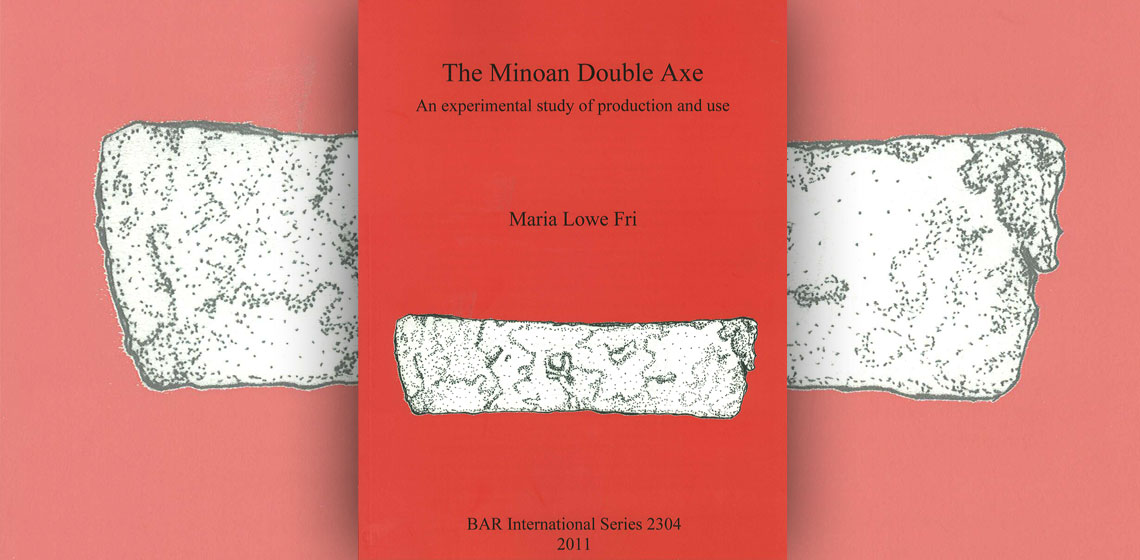
British Archaeological Reports has once again provided the world with an excellent publication on experimental archaeology. Maria Lowe Fri’s book is a revised version of her Ph.D. thesis at Stockholm University (2007). As the title indicates, it focuses on the Minoan double axe, providing a review of previous research (typologies and formal analysis) on such axes before exploring the archaeological evidence for double axe production in Crete, where she not only reviews the evidence for axes of different metallic composition (copper, arsenical bronzes, and tin-bronzes), but also explores the nature of their manufacture with moulds, crucibles, and various finishing techniques.
Having laid the foundation, Lowe Fri begins her analysis with the visual examination of 23 axes housed in four museums (one in England and three in Crete). By looking for evidence for a wide array of casting evidence and defects, as well as finishing treatments (including decoration), she was able to detect several different aspects of the manufacturing process, such as mould types used and even the temperature of the molten metal when poured into the moulds. She also noted that different finishing techniques were often responsible for the axes differing shapes (e.g. resulting from differential hammering) rather than differences in the moulds used to produce the axes.
Lowe Fri then turns to an analysis of the use of the double axes. Here she looks at the composition of the metal axes to understand the nature of their hardness. She then turns to use-wear on cutting edges as well as the axe bodies. In the end, the use-wear corresponded to the working actions of cutting, chopping, and breaking, suggesting that Minoan double axes were used for a variety of activities.
With all of the visual analysis completed, Lowe Fri then turns to experimentation. This without doubt is the most interesting chapter (at least for this author). Her experimental work is quite comprehensive, taking the reader through the manufacturing process, finishing treatments, hafting, and then the use of the resulting axe. Here she begins with using it as a chopping tool for wood; first on a Scotch fir tree, then a birch tree, and finally an oak. Next, she uses the axe to dress and split stone. Finally, she sets her hand to butchering a lamb and then cattle bones. She concludes this chapter with the observation that “A double axe can be used to fell trees of different hardness, dress softer stone and cut up both small and large animals. The experiments show that a woodworker or a carpenter, a stonemason and a butcher could indeed have used a double axe to perform their work.”
In her penultimate chapter, Lowe Fri turns to an analysis of the use and users of Minoan double axes. She begins by undertaking use-wear analysis on the axes in her sample and then turns to their find locations and contexts (e.g. mortuary contexts and habitation areas). In the end, she identifies three distinct ancient professions: stonemason, woodworker, and butcher.
Lowe Fri concludes her study with a nice, concise summary over 2+ pages, followed by a catalogue of 229 double axes she has identified in the literature, a glossary of terms, appendices with the details of the axes and other tools she manufactured as part of her study, and then a bibliography. In all, a most satisfying experimental archaeology study.
Reviewed by James R. Mathieu, University of Pennsylvania Museum of Archaeology and Anthropology (Philadelphia, PA, USA)
Book information:
LOWE FRI, M., "The Minoan Double Axe, an experimental study of production and use", BAR International Series, vol. 2304, Oxford, Archaeopress, 2011.
LOWE FRI, M., "The double axe in Minoan Crete: a functional analysis of production and use", Department of Archaeology and Classical Studies, Stockholm, Stockholm University, pp. 288, 2007.